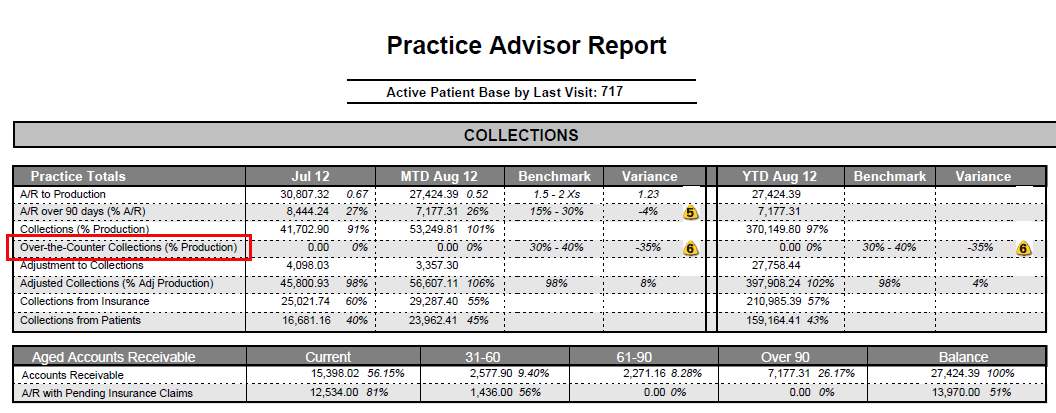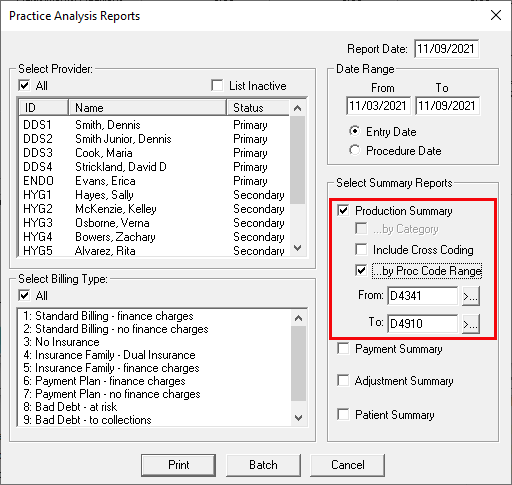Discover the numbers that can be influenced by minor changes in financial policies or language skills that will have a big impact on the health of the practice.
Updated 11/9/21
Numbers tell a story. The numbers help you reinvent systems, protocols, and campaigns. That’s why it’s important to monitor your practice statistics. When I say “monitor,” I don’t mean you write the numbers down on your spreadsheet, stick it in the 3-ring binder, and forget about it. I mean you are tracking it, discussing it with your doctor, talking about it with your team, and coming up with strategies as a team to improve it or high-fiving each other because you are exceeding your expectations.
I was recently working with a dental practice that has three front office team members. They each have a list of statistics they have to track on a daily, weekly, and monthly basis. When they hired me to do some training, they wanted help with extracting information from their software so it would be easier for them to complete their time-consuming tasks. I was looking at the stats they were tracking and asked them two questions: “What do you all do with this information?” and “How do these numbers help your job, your practice, and your patients?” The answer from all three team members was the same—“I don’t know. The doctor just wants it.”
I recently had a similar conversation with a very good friend of mine. I asked her, “What does your doctor do with the information? Do you talk about it at the team meetings and discuss the numbers?” Her response was, “No, he just gives them to the consultant.”
Another situation I find is the office that doesn’t track anything at all. I have asked doctors on the spot what their Accounts Receivable number is and they can’t tell me. I have asked financial coordinators what the over-the-counter collections are for the office and they don’t know.
I find that there is a common disconnect here between just tracking stats and actually monitoring stats and trends to use in your dental practice to help make it more profitable and productive. What I find with many offices is that the front office team spends hours throughout the month tracking statistics. Then they give the numbers to the doctor and never hear anything back. They then start the process over again the next month with the same result.
Like I said earlier, numbers tell a story. You need to be able to use the numbers to help write the next chapter and deliver an ending that is more predictable and not just leave your bottom line to chance. When I talk about monitoring trends, I mean looking at numbers over a 3-month average rather than on a month-to-month basis. I have worked in the dental practice for more than 20 years, so I know that every office can have a bad month, but if you track the statistics on a 3-month average, you can get a better picture of the health of the practice.
It goes without saying that you should be monitoring the gross/net production and collection numbers. Here are the other numbers I recommend that office monitor.
1- Over-the-Counter Collections
I am a big enforcer of collecting over the counter, and I want offices to track this number very closely. Your money is worth more today than it is 30 or 90 days from now, and it makes a huge impact on the bottom line of the practice to collect at time of service. This might sound high to you, but I want to see OTC at 45-55% for fee-for-service practices.
Getting to this number starts with the new patient phone call and training patients that payment is due at the time of service, then continues with the treatment plan presentation when creating a financial arrangement that conforms to this philosophy. Finally, at the time of the appointment when your patient is checking out, your team must have the language skills needed to ask for payment before the patient leaves. In Dentrix, follow these recommendations for helping you extract this number more easily and accurately.
- Create separate payment types for OTC cash, OTC check, and OTC credit card. This way when you need to run reports, it will separate this information out.
- Generate the Practice Advisor Report (Office Manager > Analysis > Practice Advisor). It will keep track of this number for you without you having to do any manual calculations.

2- Net New Patients
Notice the word “net.” Many of the offices I work with are very proud and brag about the number of new patients they get every month until I ask for the number of patients who leave each month. They then look at me like I came from outer space. If you are getting 30 new patients a month but have 20 patients leaving every month, you really only have 10 new patients. Now it doesn’t sound so good, does it?
I don’t mean to burst your bubble, but it is important to know why your patients are leaving and how you can use this information to retain patients in the future. My recommendation is to follow up with your patients who are leaving with an exit phone call and try and find out the reason for the transfer. If it is a reason you can prevent in the future, this will help your “net” new patient number improve.
- Dentrix will keep track of new patients for you (by first visit date). You can run a New Patient List or the Practice Advisor Report will track this number as well.
- What you will need to keep track of manually is the number of patients leaving the practice in order to get the “net” new patients.
3- Percentage of Perio Production to Overall Hygiene Production
The hygiene department is an important piece of the dental team and we need to keep a close eye on what is being scheduled out of this chair. I find the most common problem is lack of diagnosing in periodontal therapy. If your hygiene department is producing less than 30% in perio services, I would seriously consider an evaluation with an experienced hygiene productivity coach. If you need a referral, contact me directly.
- To get this number from your Dentrix reports, you will need to run a Practice Analysis Production Summary Report (Office Manager > Analysis > Practice) by procedure code and filter it from D4341 to D4910.
- Then divide this number by your overall hygiene production.

Unscheduled Time Units
This number can go up and down, especially depending on the time of year. Offices tend to see more unscheduled time units during the summer months because people want to play hooky in the sunshine. Therefore, it is important to trend this number over a 3-month average just like all the other statistics. If you have more than 3 units of unscheduled time in the hygiene department per day, then you may want to look at new ways of making sure patients understand how important it is to keep their appointments.
If patients are skipping out on their hygiene appointments, it could be because they don’t consider their oral health a priority so it is important for the hygienist to plant a seed that the patient will remember. For example, you could say, “if that pocket on that upper right tooth doesn’t improve, we may need to refer you to a specialist or we need to watch that crack on tooth #4 very closely.” Patients could also skip out on their appointments because they know that if they call, they can get in within a couple of days. After all, they’ve done it before. To stop this from happening, the front office must have verbal skills ready to deal with these habitual schedule changers.
- The Practice Advisor Report will track this number automatically for you.
- Make sure that you have your Appointment Book set up with the office hours and days open, as well as the Provider hours and days set up properly.
- If you need help with this, open up the help icon inside the Practice Advisor Report and it will walk you through it.
Accounts Receivable
Back in the day, it wasn’t uncommon for the dental office to carry balances a lot more than they do today. With today’s economy and uncertainty in employment, you need to be a little more cautious about extending a payment plan. In today’s environment, this number should trend under a month’s production (when you take your total accounts receivable and divide it by your total month production, it should be less than 1).
It is also extremely important to monitor not only your positive accounts receivable but also your credit balances. I don’t know the laws in your state, but here in Washington we must report and send any non-active credit balances to the Department of Revenue and they will list it up on their unclaimed property report.
- The Practice Advisor Report will track your Accounts Receivable for you.
- You can also run the Provider A/R Totals report or an Aging Report for this information.
Over the years working in the dental practice, I have tracked and monitored many more numbers than the five I just listed, but these are the big ones. These are the numbers that can be influenced with minor changes in financial policies or language skills that will have a big impact on the health of the practice.
Learn More
To learn about other statistics you should monitor, read Know Your Numbers, Know Your Practice.
For more information about the Practice Advisor, read Measuring Your Practice’s Financial Health or see the Practice Advisor Report topic in Dentrix help.
By Dayna Johnson, Dentrix Certified Trainer
Dayna loves her work. She has over 25 years of experience in the dental industry, and she’s passionate about building efficient, consistent, and secure practice management systems. Dayna knows that your entire day revolves around your practice management software—the better you learn to use it, the more productive and stress-free your office will be. In 2016, Dayna founded Novonee ™, The Premier Dentrix Community, to help cultivate Dentrix super-users all over the country. Learn more from Dayna at www.novonee.com and contact Dayna at [email protected].





